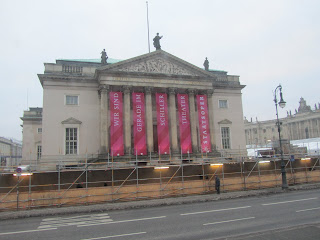
1 HOLOCAUST MEMORIAL AND MUSEUM
Wishing to make a further dent in our list, we started our day early, taking the U-bahn and arriving at the downtown Holocaust Memorial before 10 am (well, early by “Vacation Standard Time” I guess). Installed in 2005, the memorial is a composite of over 2,000 rectangular stone monoliths, arranged in neat rows upon an undulating plaza. The stones have no carving or plaques, nor are there any signs to speak of. Instead, the memorial is blankly quiet, as if to invite the visitor’s inquiry and personal reflection.
I had all kinds of images in mind as I walked through the memorial…the lines of barracks buildings I’ve seen in concentration camp photos, columns of headstones in a cemetary, and of course the many victims whose names are yet unknown to us.
Also part of the Memorial is an underground museum, beneath the field of stones. In a striking moment of architectural inspiration, the

museum ceiling is cast as an echo of the above ground stone topography, as if the monoliths above had been pushed up from the space below. The iconic visual device helps keep those whom we honor close to mind.
In addition to presenting some of the facts of the holocaust, the museum helps its visitors understand the tragedy at a personal level, by dedicating two large rooms to historical pictures of families, reproductions of letters, telegrams and deportation orders and information about their fates, if known. Though the facts are devastating to contemplate, we found these presentations did their work in a manner that was effective and honorable.
Across the street from the memorial is large city park, Tiergarten (“Animal Garden,” since the city zoo is contained in it). Among the many monuments it contains are the Goethe Monument and a new Memorial to Homosexual Victims of the Holocaust. The plaque next to it reads, in part: For many years, the homosexual victims of National Socialism were not included in public commemorations—neither in the Federal Republic of Germany nor in the German Democratic Republic….With this memorial, the Federal Republic of Germany intends to honor the victims of persecution and murder, to keep alive the memory of this injustice, and to create a lasting symbol of opposition to enmity, intolerance and the exclusion of gay men and lesbians. The starkly plain construction of this Memorial recalls the design of the Holocaust Memorial just across the street. Through the small opening in the side, one views a looped video image of two men embracing, recorded at the actual site in the park where the monument stands.


2 MUSEUMINSEL
Our next goal was the Pergamon Museum, located on a sliver of island in the River Spree. Walking through the Brandeburg Gate and down the grand promenade, we passed the US Embassy, the Opera House and a very glitzy Mercedes dealership!
The “Museum Island” contains Berlin’s largest collections of fine art, in several classical buildings. Adjacent is the Berlin Cathedral.
The Pergamon Museum houses two significant archeological finds from Turkey: the Pergamon Altar (a nearly 400' long frieze) and the Market Gate of Miletus. The enormity of these two installations is breathtaking.
Also located in the Pergamon is the Ishtar Gate, from the wall that ringed the ancient city of Babylon. Excavated in the 1930's, the gate is 47' high and 100' feet wide. Jon and I liked the shiny animal reliefs installed among the bright blue bricks.








Photos are lovely. It looks cloudy there, much the same as an Indiana winter - and yet the grass looks very green! Travel safely.
ReplyDeleteThanks for all the updates and photos of your trip! I enjoyed reading about all these places.
ReplyDelete